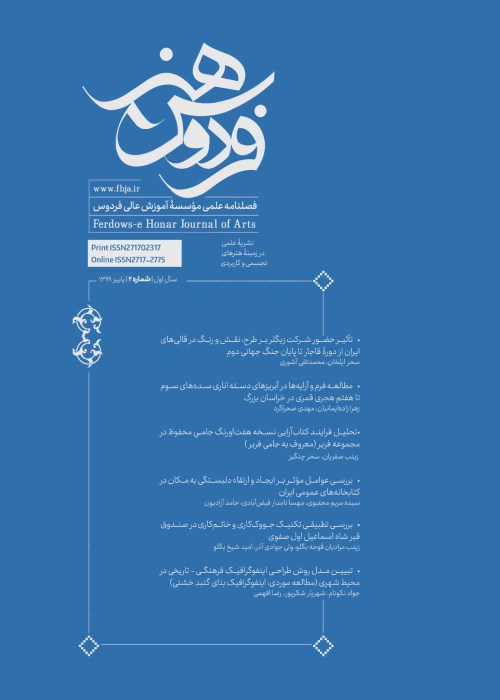The themes of "White Devil" and its symbolic representation in Shahnameh of the Safavid era
Myths are generally full of narratives about gods, superhuman beings and amazing events that happened in the structure of the first civilizations, with qualities different from the qualities of our time, and they refer to the creation of the wo rld and its administration. Or they will occur in the distant future. Ferdowsi's Shahnameh, as the most prominent epic work of Iran, represents many myths and beliefs of ancient Iranians, which has been the subject of many cultural and artistic discourses common in this land until today. Especially since a large part of the history of painting in Iran is devoted to Shahnameh painting, and many Iranian artists and painters in different historical periods have been engaged in interpreting the themes of the Shahnameh in visual expression. Dealing with the symbolic aspects of Iranian mythology and how these symbols are represented in the visual arts of Iran is important because it can lead to a better understanding of the art and culture of Iran during the Safavid period. In addition to these, examining the implicit concepts and underlying layers of Iranian visual and cultural elements can lead to new and dynamic ideas in the field of visual arts. It is necessary to pay attention to the fact that sometimes symbols and visual signs are able to convey information that words cannot. The image is more aggressive than the text; The image is a more accurate indication. Its meaning is often closer to the subject. The image becomes a text from the moment it signifies something, and for this reason, like writing, it is called a readable unit. The image in different works can only bring a moment of narrative and writing to the eye. In search of the chain relationship between this moment of narration and writing, it is possible to identify different symbolic systems. Therefore, the goal of image semiotics is to discover the rules of image reading and understanding its meanings through the recognition of visual elements or the appearance of the image, which leads to the analysis of the configuration of the image elements, and in the next step, it leads to the analysis of the forms and recognition of the signified meanings. In the history of Iran after Islam, the Safavid era is considered a turning point in terms of important political-social developments, which begins with the revolutionary government of Shah Ismail Safavid. Safavid painting, like other branches of art, was not exempted from this influence, and perhaps more than other branches, signs of social changes can be observed in it. The battle of Rostam and the White Devil is the seventh book of Rostam's books in Ferdowsi's Shahnameh, whose events have been illustrated many times by Iranian painters. According to Ferdowsi's narrative, the White Devil has a black face, white hair, and a large and powerful body, and lives in a dark and terrifying cave. These characteristics have found various manifestations in the paintings related to the story of the battle of Rostam and the White Devil, and considering their symbolic nature, it seems that they have been depicted in each period according to the current interpretations in the social and cultural relations of the time. Although various interpretations of the metaphors and symbols used in the story of the battle between Rostam and the White Devil in the Shahnameh have been presented so far, this issue has not been addressed in the semiotics of the image and researches in the field of painting. Discusses the portrayal of the White Devil in various paintings of the Safavid period in Iran and analyzes the symbolic functions of this myth in the illustrations of the Shahnameh of Tahmasbi, the Shahnameh of Shah Abbasi and the Shahnameh of Qavam Ibn Mohammad Shirazi, the Shahnameh of Shah Ismail II, the Shahnameh of Shamlu and the Shahnameh of 953 AH. Pay Paris. Therefore, considering the importance of the relationship between text and image in the studies of this field, the main problem of the upcoming research is how to represent the symbolic aspects of the White Devil in Iranian pictorial culture and especially the Shahnameh of the Safavid era in Iran. The results of the studies carried out in this article indicate that the white devil in these paintings is a symbol of evil, helplessness and ill-temper, which was defeated by the Iranian epic hero Rostam in the 7th century. The way of drawing the figure of the White Devil has a more or less identical pattern to most of the paintings of this era, which is rooted in the painting tradition of Timurid Iran and is largely consistent with Ferdowsi's description of it in the narrative of the Shahnameh.
- حق عضویت دریافتی صرف حمایت از نشریات عضو و نگهداری، تکمیل و توسعه مگیران میشود.
- پرداخت حق اشتراک و دانلود مقالات اجازه بازنشر آن در سایر رسانههای چاپی و دیجیتال را به کاربر نمیدهد.


